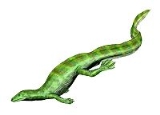
Hovasaurus
Encyclopedia
Hovasaurus is an extinct genus
of diapsid
reptile
belonging to the Order Eosuchia
. It lived in what is now Madagascar
during the Late Permian.
Hovasaurus resembled a slender lizard, and was around 50 centimetres (19.7 in) long, of which two thirds was taken up by its long tail. It was well adapted to an aquatic
life, with the tail being laterally flattened like that of a sea snake. Some stones have been found in the abdomen of fossil Hovasaurus, indicating the creatures swallowed these for ballast
, preventing them from floating to the surface when hunting fish.
Genus
In biology, a genus is a low-level taxonomic rank used in the biological classification of living and fossil organisms, which is an example of definition by genus and differentia...
of diapsid
Diapsid
Diapsids are a group of reptiles that developed two holes in each side of their skulls, about 300 million years ago during the late Carboniferous period. Living diapsids are extremely diverse, and include all crocodiles, lizards, snakes, and tuatara...
reptile
Reptile
Reptiles are members of a class of air-breathing, ectothermic vertebrates which are characterized by laying shelled eggs , and having skin covered in scales and/or scutes. They are tetrapods, either having four limbs or being descended from four-limbed ancestors...
belonging to the Order Eosuchia
Eosuchia
Eosuchians are an extinct order of diapsid reptiles. Depending on which taxa are included the order may have ranged from the late Carboniferous to the Eocene but the consensus is that eosuchians are confined to the Permian and Triassic....
. It lived in what is now Madagascar
Madagascar
The Republic of Madagascar is an island country located in the Indian Ocean off the southeastern coast of Africa...
during the Late Permian.
Hovasaurus resembled a slender lizard, and was around 50 centimetres (19.7 in) long, of which two thirds was taken up by its long tail. It was well adapted to an aquatic
Aquatic animal
An aquatic animal is an animal, either vertebrate or invertebrate, which lives in water for most or all of its life. It may breathe air or extract its oxygen from that dissolved in water through specialised organs called gills, or directly through its skin. Natural environments and the animals that...
life, with the tail being laterally flattened like that of a sea snake. Some stones have been found in the abdomen of fossil Hovasaurus, indicating the creatures swallowed these for ballast
Sailing ballast
Ballast is used in sailboats to provide moment to resist the lateral forces on the sail. Insufficiently ballasted boats will tend to tip, or heel, excessively in high winds. Too much heel may result in the boat capsizing. If a sailing vessel should need to voyage without cargo then ballast of...
, preventing them from floating to the surface when hunting fish.

